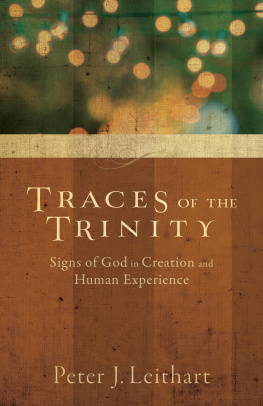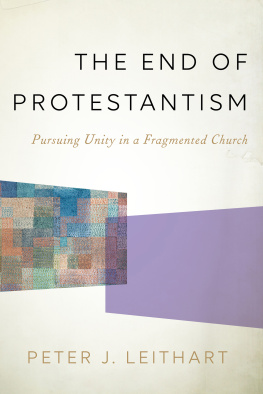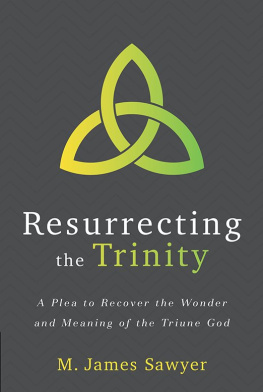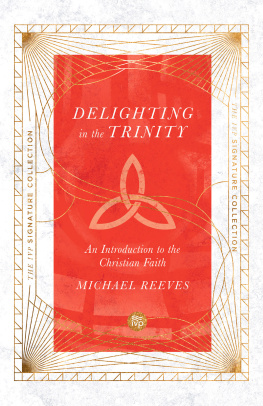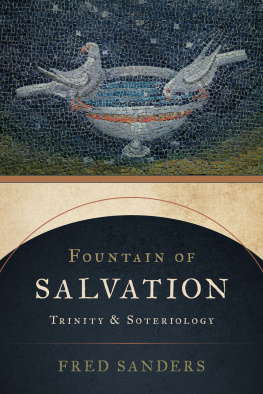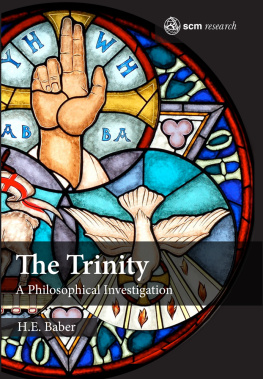Peter J. Leithart - Traces of the Trinity: Signs of God in Creation and Human Experience
Here you can read online Peter J. Leithart - Traces of the Trinity: Signs of God in Creation and Human Experience full text of the book (entire story) in english for free. Download pdf and epub, get meaning, cover and reviews about this ebook. year: 2015, publisher: Baker Publishing Group, genre: Religion. Description of the work, (preface) as well as reviews are available. Best literature library LitArk.com created for fans of good reading and offers a wide selection of genres:
Romance novel
Science fiction
Adventure
Detective
Science
History
Home and family
Prose
Art
Politics
Computer
Non-fiction
Religion
Business
Children
Humor
Choose a favorite category and find really read worthwhile books. Enjoy immersion in the world of imagination, feel the emotions of the characters or learn something new for yourself, make an fascinating discovery.
- Book:Traces of the Trinity: Signs of God in Creation and Human Experience
- Author:
- Publisher:Baker Publishing Group
- Genre:
- Year:2015
- Rating:5 / 5
- Favourites:Add to favourites
- Your mark:
- 100
- 1
- 2
- 3
- 4
- 5
Traces of the Trinity: Signs of God in Creation and Human Experience: summary, description and annotation
We offer to read an annotation, description, summary or preface (depends on what the author of the book "Traces of the Trinity: Signs of God in Creation and Human Experience" wrote himself). If you haven't found the necessary information about the book — write in the comments, we will try to find it.
Peter J. Leithart: author's other books
Who wrote Traces of the Trinity: Signs of God in Creation and Human Experience? Find out the surname, the name of the author of the book and a list of all author's works by series.
Traces of the Trinity: Signs of God in Creation and Human Experience — read online for free the complete book (whole text) full work
Below is the text of the book, divided by pages. System saving the place of the last page read, allows you to conveniently read the book "Traces of the Trinity: Signs of God in Creation and Human Experience" online for free, without having to search again every time where you left off. Put a bookmark, and you can go to the page where you finished reading at any time.
Font size:
Interval:
Bookmark:
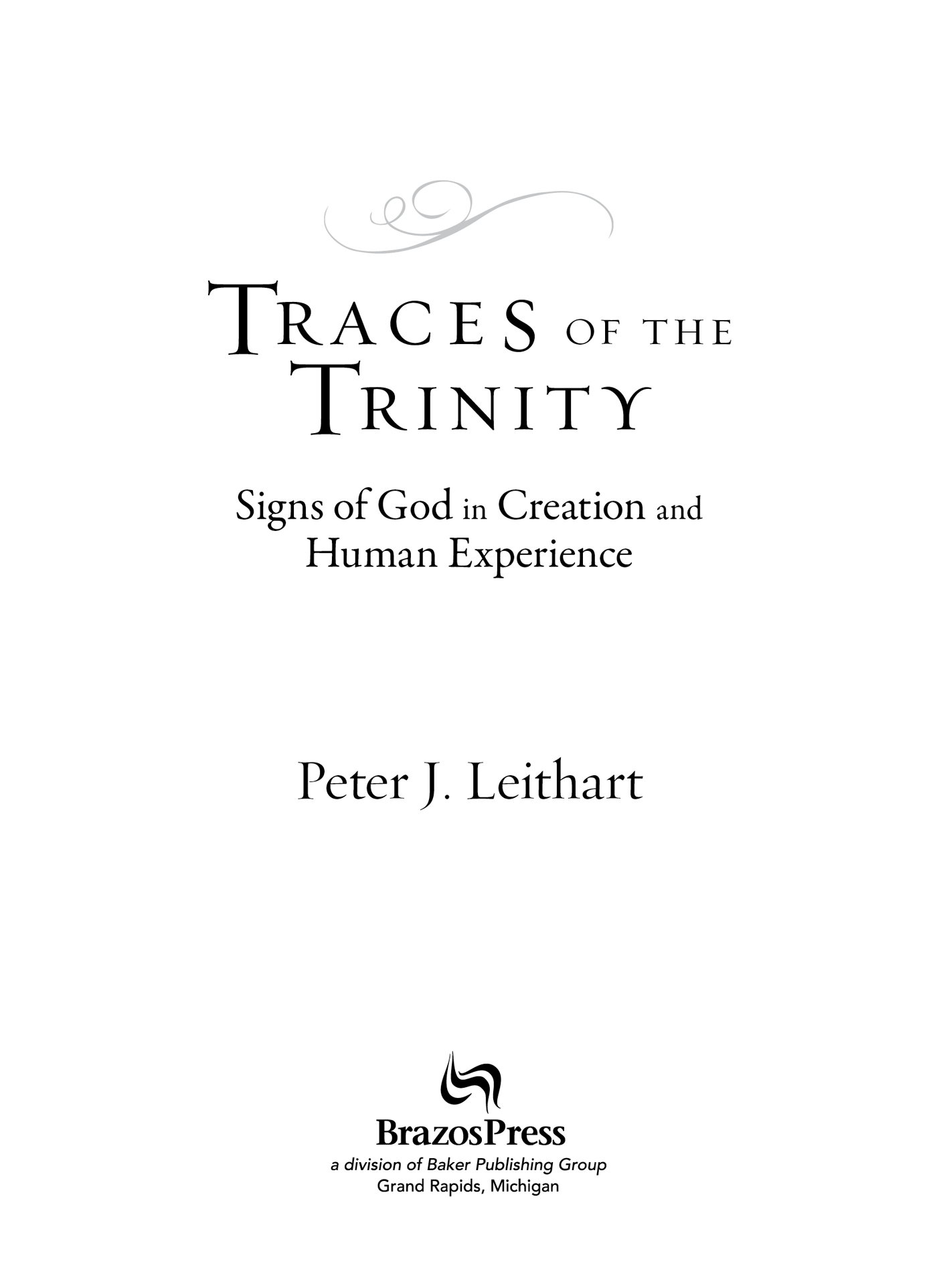
2015 by Peter J. Leithart
Published by Brazos Press
a division of Baker Publishing Group
P.O. Box 6287, Grand Rapids, MI 49516-6287
www . brazospress .com
Ebook edition created 2015
All rights reserved. No part of this publication may be reproduced, stored in a retrieval system, or transmitted in any form or by any meansfor example, electronic, photocopy, recordingwithout the prior written permission of the publisher. The only exception is brief quotations in printed reviews.
Library of Congress Cataloging-in-Publication Data is on file at the Library of Congress, Washington, DC.
ISBN 978-1-4412-2251-0
Unless otherwise indicated, Scripture quotations are from the New American Standard Bible, copyright 1960, 1962, 1963, 1968, 1971, 1972, 1973, 1975, 1977, 1995 by The Lockman Foundation. Used by permission. Quotations from John 17 are from the 1977 edition.
To Elliot Paige Leithart
While Traces of the Trinity was going through the editorial process, my son Sheffield and his wife, Laura, opened their home to their first child, a daughter, Elliot Paige. I complete the book with the prayer that the Spirit of Jesus will forever make his home in Elliot, as he already has, and that she will find a permanent dwelling place in Jesus her Lord. May the Spirit enlarge her, so she will be capacious for her parents, for her future siblings and spouse and children, and for many, many friends. Elliot and I have not yet met, but I trust that the Spirit is already preparing a place in her heart for me, as he has made room in my heart for her.

Cover
Title Page
Copyright Page
Dedication
Preface
1. Outside In, Inside Out
2. Like Father, Like Son
3. I Am His, He Is Mine
4. Presence of the Past
5. Word in Word in World
6. Chords
7. Making Room
8. The Supple Imagination
9. I in Thee, Thou in Me
Postscript
Notes
Back Cover
Preface
. See John Frame, Doctrine of God (Phillipsburg, NJ: P&R, 2002), appendix A, for a list of over one hundred triads that may illumine or reflect the reality of the Trinity.
. I have in mind Jrgen Moltmann, specifically.
. Colin Gunton, Robert Jenson, John Milbank, and John Zizioulas have been the most formative for me.
Chapter 1 Outside In, Inside Out
. This is one of Descartess most important mistakes. I am not a seeing, experiencing thing inside the box of my body. Its my body doing the seeing and experiencing. Once we correct Descartes there, we have to re-envisage everything else too.
. Maurice Merleau-Ponty, Phenomenology of Perception (London: Routledge, 1962), 82, quoted in James K. A. Smith, Imagining the Kingdom: How Worship Works (Grand Rapids: Baker, 2013), 44.
. Merleau-Ponty, Phenomenology of Perception , xixii, quoted in Smith, Imagining the Kingdom , 42. Martin Heidegger coined his own German term to describe what we actually are. Human beings are Dasein , which means Being-there. We are beings, but if we stop with that, we can easily think of ourselves as beings that float above the world or hide outside the world, or who can survey the world from a safe mental perch somewhere. We are not merely beings but beings who are always there , always somewhere, and we are surrounded by objects that already have their uses, uses we have to learn.
or defecating. Tom Rawstorne, The Man Who Says He Hasnt Eaten or Drunk for 70 Years: Why Are Eminent Doctors Taking Him Seriously?, Mail Online , May 8, 2010, http://www.dailymail.co.uk/news/article-1274779/The-man-says-eaten-drunk-70-years-Why-eminent-doctors-taking-seriously.html. Jani claims that he received his ability to live without normal sustenance from his devotion to the Hindu goddess Amba.
. Rupert Sheldrake has explored alternative accounts of sight in The Sense of Being Stared At (New York: Random House, 2004). He claims that vision involves projections that extend beyond the brain and the body: Projection takes place through perceptual fields, extending out beyond the brain, connecting the seeing animal with that which is seen. Vision is rooted in the activity of the brain, but is not confined to the inside of the head. Like magnetic fields, minds create perceptual fields (4243). If Sheldrake is correct, then the thesis of this chapter is further strengthened.
. Diane Ackerman, A Natural History of the Senses (New York: Random House, 2011), 10.
. Philip Jenkins, Laying Down the Sword: Why We Cant Ignore the Bibles Violent Verses (San Francisco: HarperOne, 2012), 1617. See Sergio Della Sala, ed., Forgetting (New York: Psychology Press, 2010); Viktor Mayer-Schonberger, Delete (Princeton: Princeton University Press, 2009).
. Rupert Sheldrake, The Science Delusion (London: Coronet Books, 2012), 59.
. Ibid., 6162.
. Karl Popper and John C. Eccles, The Self and Its Brain: An Argument for Interactionism (London: Routledge, 1984), quoted in Sheldrake, Science Delusion , 6061.
. Kelly Cline, Solid Objects Are Mostly Empty Space, Independent Record , June 6, 2012, http://helenair.com/lifestyles/health-med-fit/solid-objects-are-mostly-empty-space/article_32b70fa2-af9f-11e1-8062-001a4bcf887a.html .
. Robert Hughes, The Shock of the New (New York: Knopf, 1991), 17.
. Bernard DEspagnat, The Conceptual Foundations of Quantum Mechanics (Reading, MA: Benjamin, 1976), 286, quoted in Sheldrake, Science Delusion , 295.
. Thats not as spooky as it sounds. An electron is only detectable if we can get a photon to interact with it. But that photon changes the way the electron is moving. Because of our method of measurement, measurements affect the thing being measured when the thing is as tiny as an electron.
. As Heidegger well knew, this insight was really a recovery of some of the central insights of ancient thought. Though Heidegger tended to look all the way back to the pre-Socratics, much of what he says about things has roots in Aristotle. For Aristotle, the final cause or purpose was one of the causes that made a thing what it is. In fact, for Aristotle, the final cause is the first cause: before you determine the materials or shape of a building, you consider what it will be used for. The final cause is a kind of ready-to-hand causation.
. This is the illustration that Philipp W. Rosemann uses to explain the fundamental premises of Thomistic metaphysics. See Omne ens est aliquid: Introduction la lecture du systeme philosophique de saint Thomas d Aquin (Louvain: Peeters, 1996), 49.
Chapter 2 Like Father, Like Son
. J. H. van den Berg, A Different Existence (Pittsburgh: Duquesne University Press, 1972), quoted in Richard Stivers, Shades of Loneliness: Pathologies of a Technological Society (Lanham, MD: Rowman & Littlefield, 2004), 2.
. The Journals of Father Alexander Schmemann , 19731983 (Crestwood, NY: St. Vladimirs Seminary Press, 2000).
. Thomas Hobbes, Leviathan (Cambridge: Cambridge University Press, 1996), 13. Why cant human beings just be sociable? Bees and ants do it, and they dont have the benefit of speech that can signify to another what he thinks expedient for the common benefit. Humans cant just get along, Hobbes thinks, for several reasons: because we compete with one another for honor; because a bees private interest is identical to its public interest; because ants lack reason and thus never protest against bad government; because, lacking speech, bees and ants also lack the capacity for deception; because animals are happy when at ease while men are most troublesome when comfortable. Above all, humans cant be like the bees and ants because the agreement of these creatures is natural; that of man is by covenant only, which is artificial (ibid., 17).
Font size:
Interval:
Bookmark:
Similar books «Traces of the Trinity: Signs of God in Creation and Human Experience»
Look at similar books to Traces of the Trinity: Signs of God in Creation and Human Experience. We have selected literature similar in name and meaning in the hope of providing readers with more options to find new, interesting, not yet read works.
Discussion, reviews of the book Traces of the Trinity: Signs of God in Creation and Human Experience and just readers' own opinions. Leave your comments, write what you think about the work, its meaning or the main characters. Specify what exactly you liked and what you didn't like, and why you think so.

